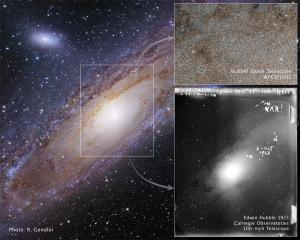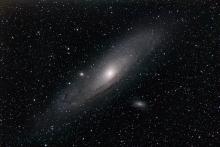A star that astronomer Edwin Hubble viewed 100 years ago this month changed our concept of the universe. The star, M31-V1, changes brightness in a regular pattern that astronomers can use to calculate the star's distance. Hubble's observations (at lower right, with M31-V1 labeled "var") demonstrated that the star's home, the starry disk known as M31, was a separate galaxy and not a mote of matter within the Milky Way Galaxy. That proved that there are myriad galaxies in the universe, greatly expanding its known size. The main image shows M31-V1's location within M31 (the Andromeda Galaxy), while the image at top right shows a close-up of the star and its busy neighborhood. [NASA/ESA/Hubble Heritage Team]
You are here
Astounding Star
It’s not often that a single star transforms our view of the universe. But it happened with a star that was photographed 100 years ago tonight. The star proved that there’s more to the universe than just the Milky Way Galaxy — much more.
The star is known today as M31-V1. It’s in M31, the Andromeda Galaxy. A century ago, M31 was called the Andromeda Nebula. Many astronomers thought it was a mote of matter inside the Milky Way. Others thought it was a separate galaxy — an “island universe” of billions of stars.
On the night of October 5th of 1923, Edwin Hubble snapped a picture of a small segment of M31. He identified three stars that had grown much brighter since the last time he looked at them. Follow-up observations showed that one star’s brightness changed from night to night.
That star was a Cepheid — a supergiant star that’s unstable. It pulses in and out like a beating heart. The duration of the pulses revealed the star’s true brightness. And from that, Hubble calculated its distance — a million light-years. Studies of other Cepheids confirmed the distance. So M31 had to be well beyond the Milky Way — vastly expanding our understanding of the universe.
Modern observations put the distance to M31 at two-and-a-half million light-years. And the galaxy is visible to the unaided eye. Under dark skies, it looks like a faint smudge of light, in the north-northeast at nightfall.
Script by Damond Benningfield
Get Premium Audio
Listen to today's episode of StarDate on the web the same day it airs in high-quality streaming audio without any extra ads or announcements. Choose a $8 one-month pass, or listen every day for a year for just $30.







